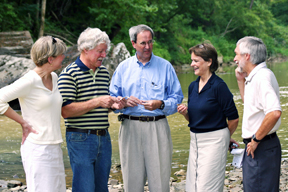Trips to the Cahaba River for many in the UAB community are calming, enlightening and sacred.
 |
| UAB faculty members (from left to right) Mindy Lalor, Ken Marion, Bob Corley, Debbie Pezzillo and retiree James Lowery stand along the Cahaba River at a canoe entrance just off Interstate 459. Several UAB employees, including the ones above, are members of the Cahaba River Society, a group dedicated to improving water quality, water supply and the habitat that sustains the health of the Cahaba. |
It’s a love affair with the stream, its natural beauty and the importance it holds in the area that has led several current and former UAB employees to embrace its preservation as one way to give back to the greater local community.
Many have elected to be a part of the Cahaba River Society, a group dedicated to improving water quality, water supply and the habitat that sustains the health of the river system, its biological diversity and human uses (such as for drinking water, recreation and education) for generations to come.
“I’ve been involved for many years with the Cahaba River Society because of my academic and research interests,” says Mindy Lalor, Ph.D., associate dean of Engineering, who was on the board of directors for six years, including one year as president. “It’s just a beautiful river. Alabama is blessed with incredible natural resources, so much so that we often take them for granted. The Cahaba River is one of those resources.”
The Cahaba River is roughly 140 miles long, starting in St. Clair County and rolling down near Selma. The river has more species of fish per mile than any other river in North America, and the river is the main drinking water source for the Birmingham Water Works Board, which serves one-fourth of the state’s population.
Scientists say the pollutants from growth and development along the river are damaging the vulnerable life in the waters and are threatening the quality and cost of the drinking water.
“Sedimentation coming in from development is the primary problem right now,” says Ken Marion, Ph.D., professor of biology. “Bare areas get the hard rains and turn the river into a mud hole that smothers the insects and fills in the little cracks and crevices in the rocks on the bottom. The food chain is then affected, and if the food is affected negatively, that affects everything else.”
The Cahaba River Society is Alabama’s largest watershed conservation organization and is recognized nationally for river stewardship.
“Being a part of UAB, we like to get involved in the community,” Marion says. “We like to think of our faculty and staff as really being involved in the community in all kinds of ways. UAB has always prided itself in that sort of way. Being involved in the CRS is a way to improve and maintain the quality of life in our community as far as recreation and scenic beauty.”
UAB also uses the Cahaba River as a teaching tool; the university has worked through the years with middle- and high-school students on water testing and water-quality issues as part of mentoring programs. Biology and engineering programs also use the river in their undergraduate curricula.
“We have about three different environment-oriented courses that we offer in biology with labs that actively bring students to the river to look at the diversity of insects and fish,” Marion says. “We look at habitats. It teaches some of the students about what a nice little jewel this is and how the changes that are occurring are negatively affecting the river.”
Max Michael, M.D., dean of the School of Public Health, says his involvement in the group goes beyond seeing the beauty of the river protected.
“One of the reasons I enjoy doing it is there’s clearly a connection between the CRS environmental activism and public health,” he says, “and what the CRS stands for is important public health issues.”
If you want to learn more or become involved in the CRS, visit www.cahabariversociety.org .